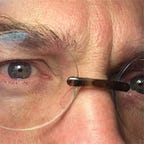In still photography, I’m always thinking about a composition and framing, light and moment that will make my photo look great as a double-page spread in National Geographic. Fast-forward to the Web and the truth is that my double-page spread looks even better and bigger on your full screen monitor.
So I was always looking and shooting for the killer “double truck,” and I hardly ever shot details because I knew they'd never run a close up as a two-page spread.
A different way to see with video
Capturing video is all about deconstructing that big picture into the component parts. A dramatic way to deconstruct the big picture is to shoot that great wide shot, then shoot a bunch of close ups inside the same shot.
When an edit can move from a close up to your killer wide shot, that variety of shots makes it more interesting for the viewer.
When I was preparing for some workshops this summer, I decided to pull the raw footage from this NYTimes series I worked on to try to explain this idea.(I’ll cover more of this in the workshops, btw)
OK, How does this work?
Below is an example of a scene I shot for Blue Chalk Media, who created the Living City Series for the New York Times. We headed north up the Hudson River to film the the Tappen Zee Bridge with historian Joan Marans Dim and her co-author, artist Antonio Masi.
When we arrived at the location that associate producer Gabriela Arp had scouted, it was very foggy. But this was our only shot and the mystery of the weather seemed to help the mood.
Building a scene, in order
Video helps create a three dimensional world so I need to think differently than a single still photo for that two page spread. Honestly, this scene was easier to capture in video because I wanted to see the characters AND the bridge. That’s impossible in a single still image.
In the spirit of deconstruction, I’ve included frame grabs of what I shot in the order I shot them to build a scene . (You’ll notice I keep saying scene, not “B” roll. )
Step-by-step and always have the camera ready
It’s a bird, it’s a bird
Editor (and Blue Chalk Creative Director) Rob Finch used the repetition of a flying bird to unify the scene when he cut this together. You can see the final scene here at the 38 second mark.
Blue Chalk producers Greg Moyer and Melanie Burford made everything happen.
What I learned
One of the biggest lessons I learned on moving from still photography to video (or motion, as people like to call it) was the need to shoot a LOT of close-ups and super close-ups and move around a lot more to capture the world from all angles.
Do you want to learn?
If you’d like to learn some more tricks about moving from still photography to effective video, come join me for a workshop. The workshops start with the assumption that you’ve never shot video before. Funny enough, by the time you leave, you’ll be shooting better stills too.
Bob Sacha is an award-winning filmmaker, photographer, editor and teacher. He’s created the video for projects that have won the Pulitzer Prize and a National News Emmy. He also leads workshops that teach video to photographers and anyone who loves visual storytelling.
